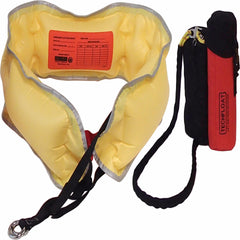With a majority of the “living space” on Earth covered by water, what can we do to avoid exploring the oceanic crust?
The idea of a life preserver has been around since early day explorers and nomads, using inflated animal bladders for support crossing water but began shaping into modern versions by Norwegian seamen, on their travels creating buoyant packages consisting of wood or cork to be used as flotation devices in case of capsize. This soon sparked inventors to develop different ring buoys, ballast belts, and full body suits. From there, designs refined, and the development of the life jacket gets a little “inflated” as several are credited with the wearable cork jacket.
- 1757 unknown Frenchman
- 1765 Dr. John Wilkinson
- 1841 Napoleon Edouard Guerin
- 1854 Captain John Ross Ward
Regardless of the original developer, the wearable chest device design grew in popularity amongst sailors for comfort and was reinforced for its life-saving properties in numerous accounts. The only drawback was weight, an individual cork jacket could weigh as much as 25 pounds! Experiments began with filling the life jacket with kapok, a light weight fiber. While less than cork, kapok still had disadvantages and foam slowly began to replace the kapok versions, allowing life jackets to self-right an unconscious wearer.

In the meantime, work was started on slimming the bulkiness of the life jacket and in 1900, Gustave Trouve patented a battery-powered life jacket that would inflate when needed. Peter Markus improved on that design throughout the 20’s, inventing a rubberized cloth with air pockets that would fill when pulled on 2 cords connected to fluid carbon dioxide. Markus pitched the idea to the U.S. Government and the idea was quickly accepted, and with World War II quickly approaching; the constant wear life jacket became regulation equipment for Navy fliers. From there life jackets began a regulated safety equipment when in 1966 aircrafts have been required to carry a life preserver for each passenger and in 1973, the US Coast Guard first introduced their regulations for Personal Flotation Devices on boats, still in use today.
With Safe Boating Week coming up it is imperative to remember that there has to be a life jacket on board for every passenger and that children wear a life jacket while on board. Did you know that an adult can drown in as little as 60 seconds and only 20 seconds for a child? This summer, make it a priority to wear your life preserver on the water. It is important to know, however, the type of vessel you’re on deems a specific type of life preserver, outlined below.

In additional to a wearable life preserver, the Coast Guard also mandates that boats 16 feet or bigger must also have a throwable device, such as a Techfloat or MOM 8-S.
|
Techfloat Inflatable Rescue Device |
MOM 8-S Man Overboard Module |
With the marine life jacket rules covered, we now turn to the skies. According to the FAA, at any given moment, there can be up to 7,000 aircraft in the sky. With over 70% of the Earth’s surface being water, it is very likely that an aircraft is over water, and in case of a bailout, pilots and passengers should be prepared. The FAA now mandates that a life preserver must be worn by all occupants while the craft is beyond autorotational distance from the shoreline.
Similar to the ones used by Navy fliers during World War II, constant-wear life vests are favored of pilots today. Constant-wear life vests consist of a pull tab that inflates the air cell, when needed and are comfortable to be worn during the flight, you put it on before boarding and you don’t worry about it until you exit. Switlik offers a variety of constant wear aviation life vests.
|
All-Pax Passenger Life Preserver |

For larger commercial flights, a life preserver is required for every passenger on board if the aircraft is flying beyond 50 miles from shore. Otherwise, a flotation device, such as a seat is sufficient. Similar to the manual inflation of the other aviation life jackets, the airline style life jackets come folded in a package, to be taken out in case of emergency.
We’ve come a long way from the original cork life jackets, and the innovations have only continued.



